Diffusion Bonding of FGH 98 and CoCrNi-Based Medium-Entropy Alloy: Microstructure Evolution and Mechanical Tests
Abstract
:1. Introduction
2. Experimental Procedure
3. Results and Discussion
3.1. Microstructure of the Joints
3.2. Mechanical Properties of Joints
4. Conclusions
- (1)
- The typical microstructure of FGH98/Ni/MEA at 1150 °C-5MPa-1 h was composed of an alloyed interlayer zone and the diffusion-affected zone (DAZ). The interlayer region and diffusion-affected region adjacent to FGH98 consisted of cubical γ′ phase, and the other DAZ on the MEA was composed of spherical γ′ phase. Both of these two type γ′ phases were coherent with the matrix.
- (2)
- As the bonding temperature increased from 1050 to 1170 °C, the amount of γ′ phase in the interlayer increased, and the morphology of interlayer γ′ phase evolved gradually from sphere to cube. The width of DAZ adjacent to MEA also increased to 7 μm when the bonding temperature was 1170 °C.
- (3)
- The microhardness and Young’s modulus of joint increased with an increase in the amount of γ′ phase. The microhardness and modulus of the DAZ near the MEA had the minimum 4.7 GPa and 183.2 GPa, while the DAZ adjacent to FGH98 reached the maximum 5.9 GPa and 210.3 GPa. The shear strength of the DB joint was increased initially and then decreased with the increase of bonding temperature from 1050 to 1170 °C. The peak value of joint shear strength was 592 MPa when the bonding temperature was 1150 °C, and the fracture morphology exhibited the typical shear dimples.
Author Contributions
Funding
Institutional Review Board Statement
Informed Consent Statement
Data Availability Statement
Acknowledgments
Conflicts of Interest
References
- Ma, Y.; Yuan, F.P.; Yang, M.X.; Jiang, P.; Ma, E.; Wu, X.L. Dynamic shear deformation of a CrCoNi medium-entropy alloy with heterogeneous grain structures. Acta Mater. 2018, 148, 407–418. [Google Scholar] [CrossRef] [Green Version]
- Miao, J.; Slone, C.E.; Smith, T.M.; Niu, C.; Bei, H.; Ghazisaeidi, M.; Pharr, G.M.; Mills, M.J. The evolution of the deformation substructure in a Ni-Co-Cr equiatomic solid solution alloy. Acta Mater. 2017, 132, 35–48. [Google Scholar] [CrossRef]
- Zhang, Z.J.; Sheng, H.W.; Wang, Z.J.; Gludovatz, B.; Zhang, Z.; George, E.P.; Yu, Q.; Mao, S.X.; Ritchie, R.O. Dislocation mechanisms and 3D twin architectures generate exceptional strength-ductility-toughness combination in CrCoNi medium-entropy alloy. Nat. Commun. 2017, 8, 14390. [Google Scholar] [CrossRef] [PubMed]
- Gludovatz, B.; Hohenwarter, A.; Thurston, K.V.; Bei, H.; Wu, Z.; George, E.P.; Ritchie, R.O. Exceptional damage-tolerance of a medium-entropy alloy CrCoNi at cryogenic temperatures. Nat. Commun. 2016, 7, 10602. [Google Scholar] [CrossRef]
- Wu, Z.; Bei, H.; Pharr, G.M.; George, E.P. Temperature dependence of the mechanical properties of equiatomic solid solution alloys with face-centered cubic crystal structures. Acta Mater. 2014, 81, 428–441. [Google Scholar] [CrossRef]
- Slone, C.E.; Miao, J.; George, E.P.; Mills, M.J. Achieving ultra-high strength and ductility in equiatomic CrCoNi with partially recrystallized microstructures. Acta Mater. 2019, 165, 496–507. [Google Scholar] [CrossRef]
- Liu, W.H.; Lu, Z.P.; He, J.Y.; Luan, J.H.; Wang, Z.J.; Liu, B.; Liu, Y.; Chen, M.W.; Liu, C.T. Ductile CoCrFeNiMox high entropy alloys strengthened by hard intermetallic phases. Acta Mater. 2016, 116, 332–342. [Google Scholar] [CrossRef]
- Zhao, Y.L.; Yang, T.; Tong, Y.; Wang, J.; Luan, J.H.; Jiao, Z.B.; Chen, D.; Yang, Y.; Hu, A.; Liu, C.T.; et al. Heterogeneous precipitation behavior and stacking-fault-mediated deformation in a CoCrNi-based medium-entropy alloy. Acta Mater. 2017, 138, 72–82. [Google Scholar] [CrossRef]
- Igor, M.; Jan, C.; Zuzana, K.; Jitka, N.; Michael, K.; Erich, N.; Ivo, K.; Vit, H.; Ivo, D. Mechanical and microstructural characterization of powder metallurgy CoCrNi medium entropy alloy. Mater. Sci. Eng. A 2017, 701, 370–380. [Google Scholar]
- Zhang, Y.; Jiang, X.S.; Fang, Y.; Fang, Y.J.; Liu, B.; Sun, H.L.; Shao, Z.Y.; Song, T.F. Research and development of welding methods and welding mechanism of high-entropy alloys: A review. Mater. Today Commun. 2021, 28, 102503. [Google Scholar] [CrossRef]
- Oliveira, J.P.; Curado, T.M.; Zeng, Z.; Lopes, J.G.; Rossinyol, E.; Park, J.M.; Schell, N.; Fernandes, F.B.; Kim, H.S. Gas tungsten arc welding of as-rolled CrMnFeCoNi high entropy alloy. Mater. Des. 2020, 189, 108505. [Google Scholar] [CrossRef]
- Chen, Z.; Wang, B.F.; Duan, B.H.; Zhang, X.Y. Mechanical properties and microstructure of laser welded FeCoNiCrMn high-entropy alloy. Mater. Lett. 2020, 262, 127060. [Google Scholar] [CrossRef]
- Yuan, L.; Xiong, J.T.; Ren, J.; Du, Y.J.; Li, J.L. Microstructure and mechanical properties in TLP joint of FeCoNiTiAl alloy and IC10 superalloy using Mn-Ni-Cr filler. Mater. Charact. 2021, 179, 111292. [Google Scholar] [CrossRef]
- Li, P.; Sun, H.T.; Wang, S.; Xia, Y.Q.; Dong, H.G.; Wen, G.D.; Zhang, H. Diffusion bonding of AlCoCrFeNi2.1 eutectic high entropy alloy to GH4169 superalloy. Mater. Sci. Eng. A 2020, 793, 139843. [Google Scholar] [CrossRef]
- Li, S.W.; Li, J.L.; Shi, J.M.; Du, Y.J.; Peng, Y.; Jin, F.; Xiong, J.T. Microstructure and mechanical properties of the brazed region in the AlCoCrFeNi high-entropy alloy and FGH98 superalloy joint. Mater. Sci. Eng. A 2021, 804, 140714. [Google Scholar] [CrossRef]
- Lei, Y.; Hu, S.P.; Yang, T.L.; Song, X.G.; Luo, Y.; Wang, G.D. Vacuum diffusion bonding of high-entropy Al0. 85CoCrFeNi alloy to TiAl intermetallic. J. Mater. Process. Technol. 2020, 278, 116455. [Google Scholar] [CrossRef]
- Peng, Y.; Li, J.L.; Shi, J.M.; Li, S.W.; Xiong, J.T. Microstructure and mechanical properties of diffusion bonded joints of high-entropy alloy Al5 (HfNbTiZr) 95 and TC4 titanium alloy. J. Mater. Res. Technol. 2021, 11, 1741–1752. [Google Scholar] [CrossRef]
- Li, P.; Sun, H.T.; Dong, H.G.; Xia, Y.Q.; Wang, S.; Hao, X.H. Microstructural evolution, bonding mechanism and mechanical properties of AlCoCrFeNi2.1 eutectic high entropy alloy joint fabricated via diffusion bonding. Mater. Sci. Eng. A 2021, 814, 141211. [Google Scholar] [CrossRef]
- Huang, H.L.; Liu, G.Q.; Wang, H.; Wang, Z.C.; Zhang, H.F.; Shao, Y.L.; Hu, B.F. Effect of cooling rate and resulting microstructure on tensile properties and deformation mechanisms of an advanced PM nickel-based superalloy. J. Alloys Compd. 2019, 805, 1254–1259. [Google Scholar] [CrossRef]
- Huang, G.C.; Liu, G.Q.; Feng, M.N.; Zhang, M.; Hu, B.F.; Wang, H. The effect of cooling rates from temperatures above the γ′ solvus on the microstructure of a new nickel-based powder metallurgy superalloy. J. Alloys Compd. 2018, 747, 1062–1072. [Google Scholar] [CrossRef]
- Zhang, X.; Li, H.W.; Zhan, M.; Zheng, Z.B.; Gao, J.; Shao, G.D. Electron force-induced dislocations annihilation and regeneration of a superalloy through electrical in-situ transmission electron microscopy observations. J. Mater. Sci. Technol. 2020, 36, 79–83. [Google Scholar] [CrossRef]
- Zhang, L.X.; Chang, Q.; Sun, Z.; Yang, Z.Y.; Feng, J.C. Diffusion bonding of hydrogenated TC4 alloy and GH3128 superalloy using composite interlayers. J. Mater. Process. Technol. 2019, 274, 116266. [Google Scholar] [CrossRef]
- Zhang, Y.; Jiang, X.S.; Fang, Y.J.; Sun, H.L.; Song, T.F.; Mo, D.F.; Li, X.; Luo, Z.P. Vacuum diffusion bonding of CoCrFeNiMo MEAs and Inconel 718 using Ni interlayer. Mater. Lett. 2020, 279, 128509. [Google Scholar] [CrossRef]
- Yang, Z.W.; Lian, J.; Wang, J.; Cai, X.Q.; Wang, Y.; Wang, D.P.; Wang, Z.M.; Liu, Y.C. Diffusion bonding of Ni3Al-based alloy using a Ni interlayer. J. Alloy. Compd. 2020, 819, 153324. [Google Scholar] [CrossRef]
- Peng, Y.; Li, J.L.; Peng, X.; Li, S.W.; Xiong, J.T.; Shi, J.M. Interfacial microstructure evolution and formation process of the joints prepared by diffusion bonding on DD6 nickel-based single crystal superalloy. J. Mater. Res. Technol. 2020, 9, 16317–16328. [Google Scholar] [CrossRef]


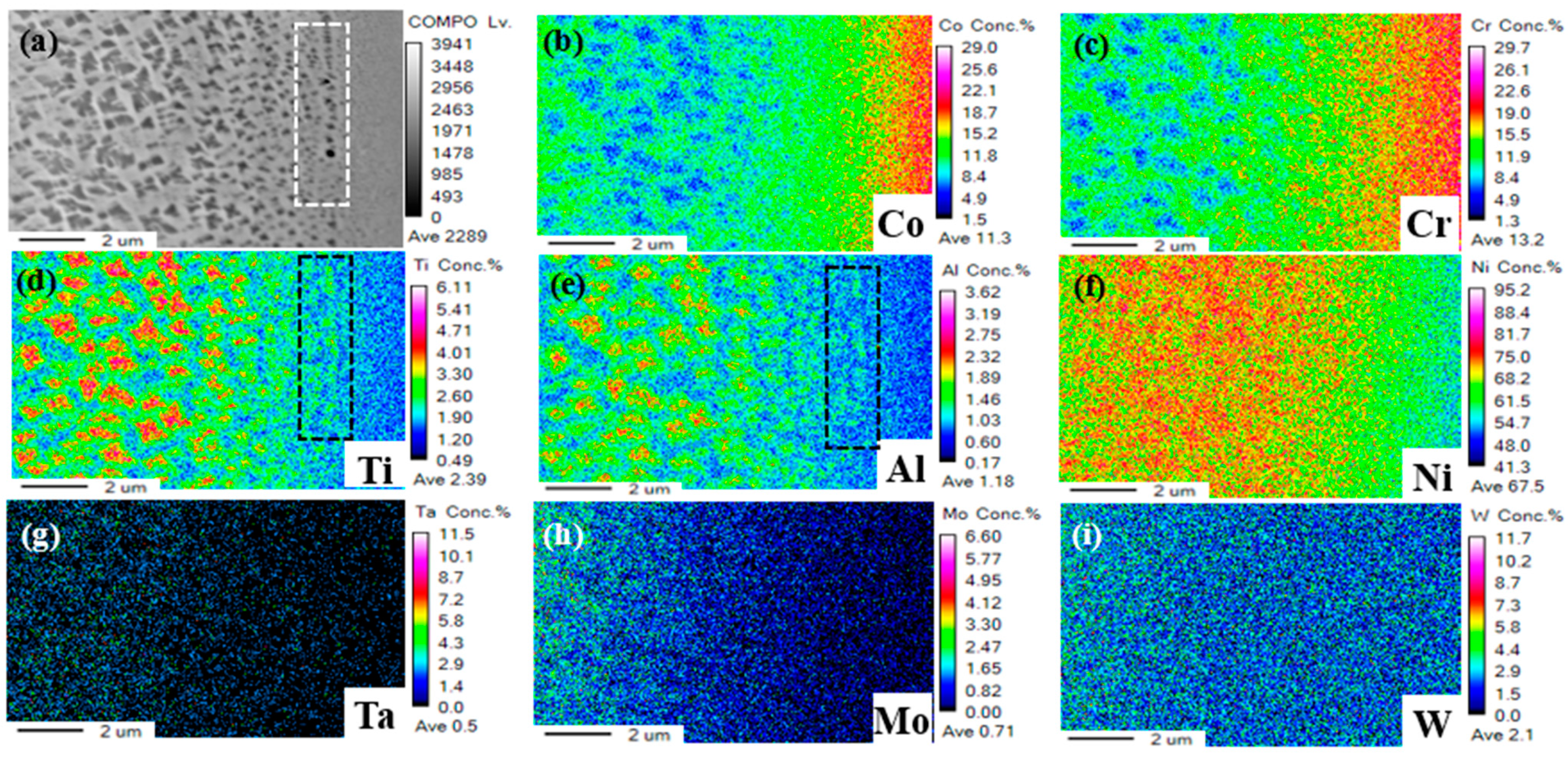
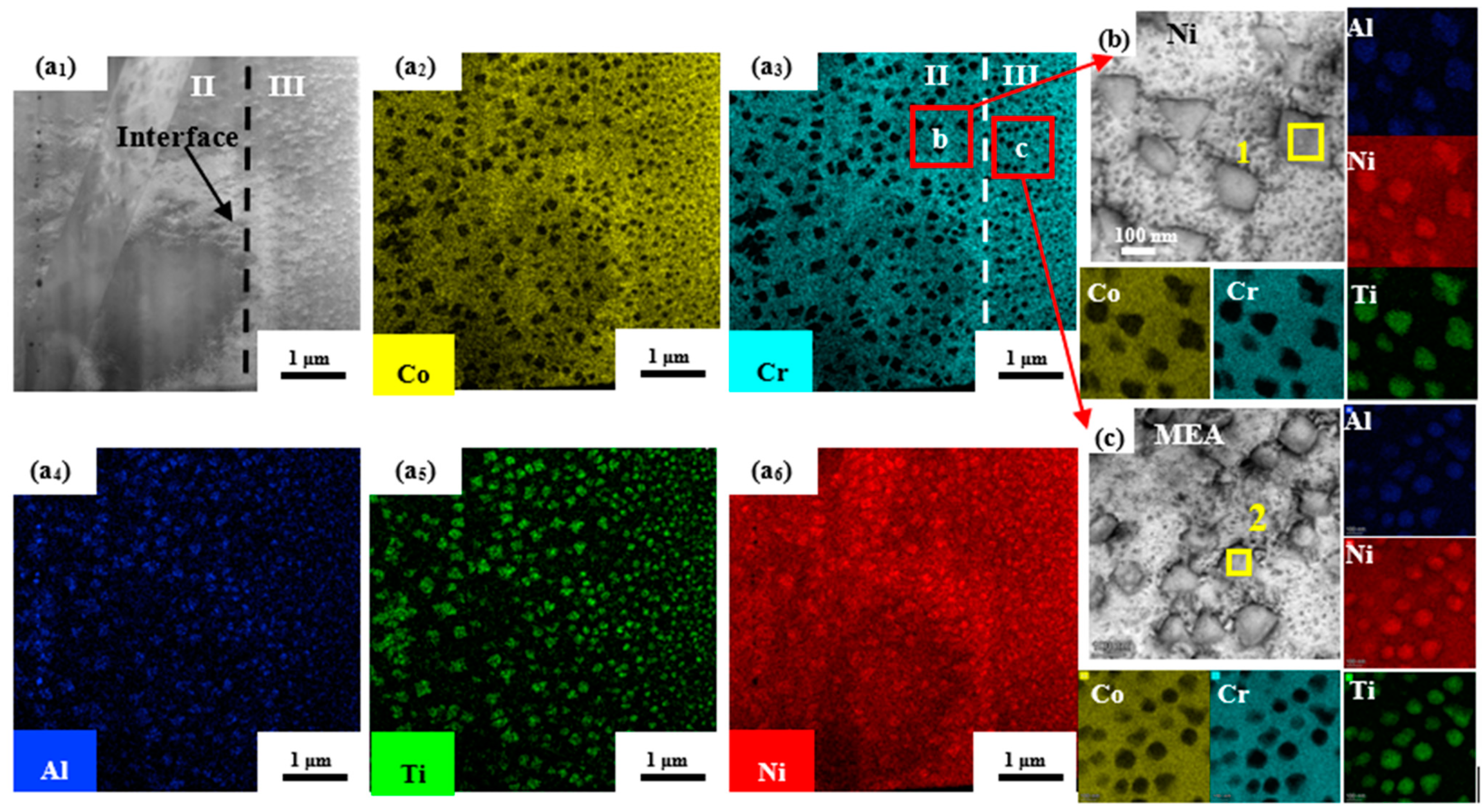
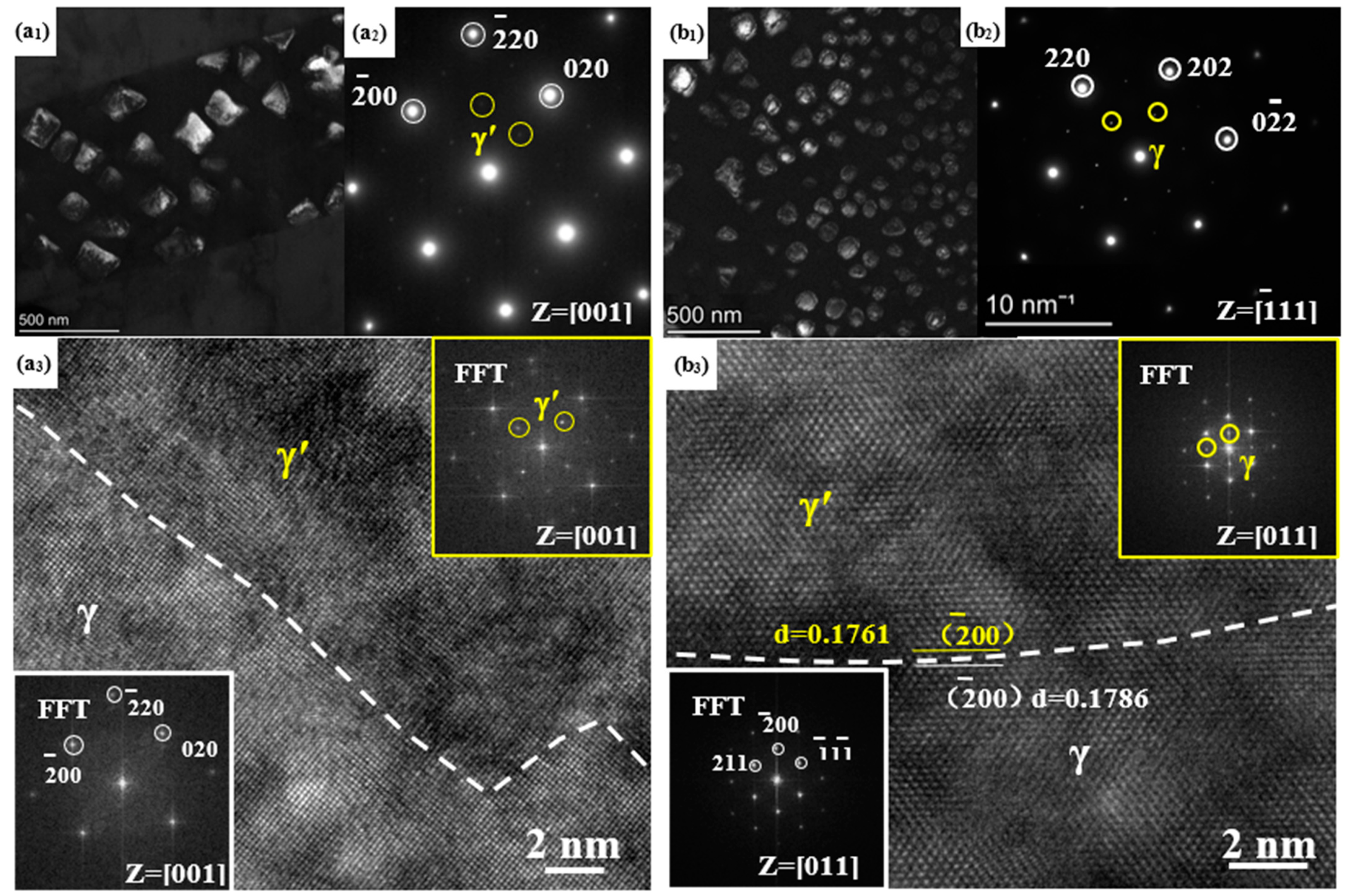
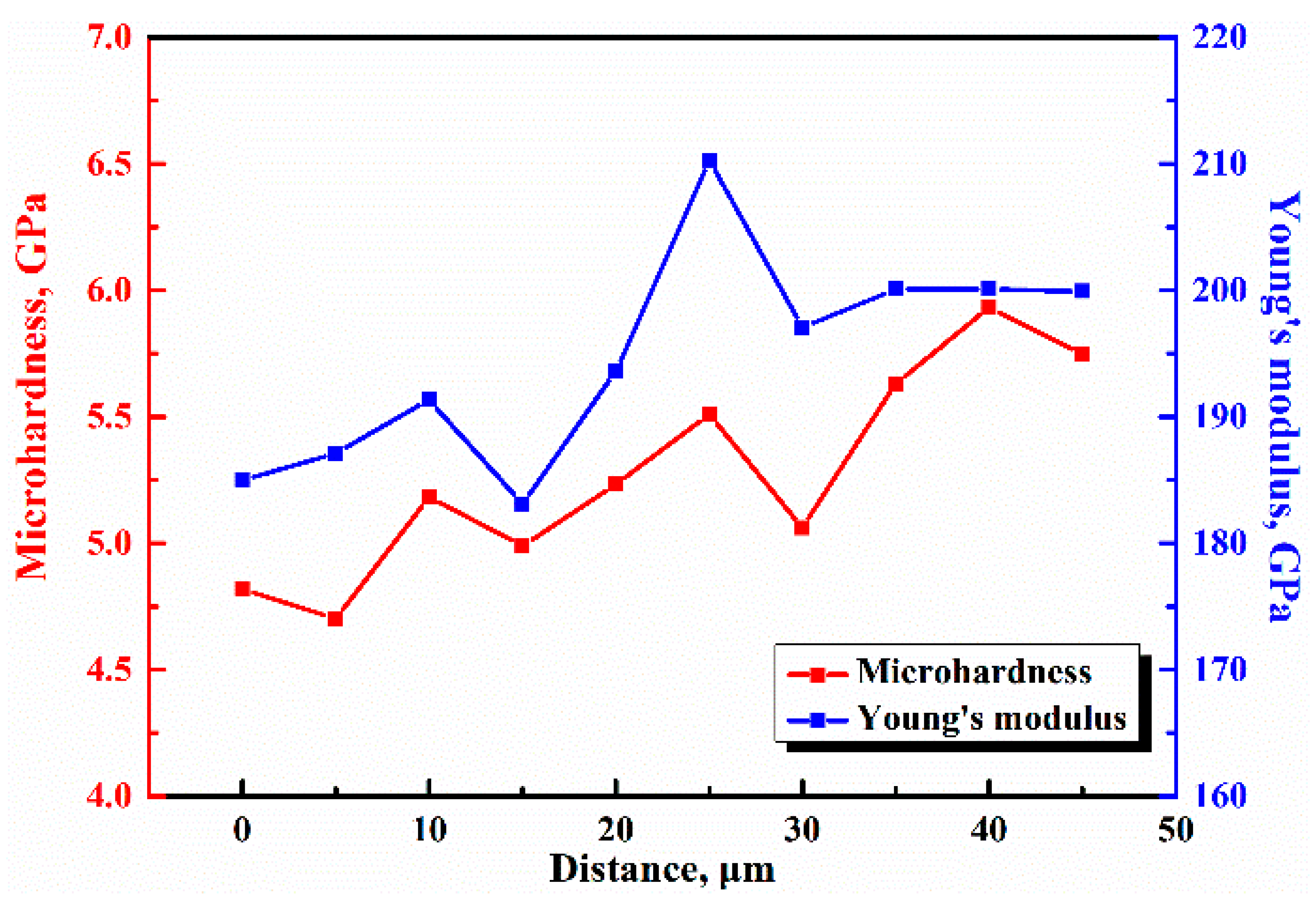
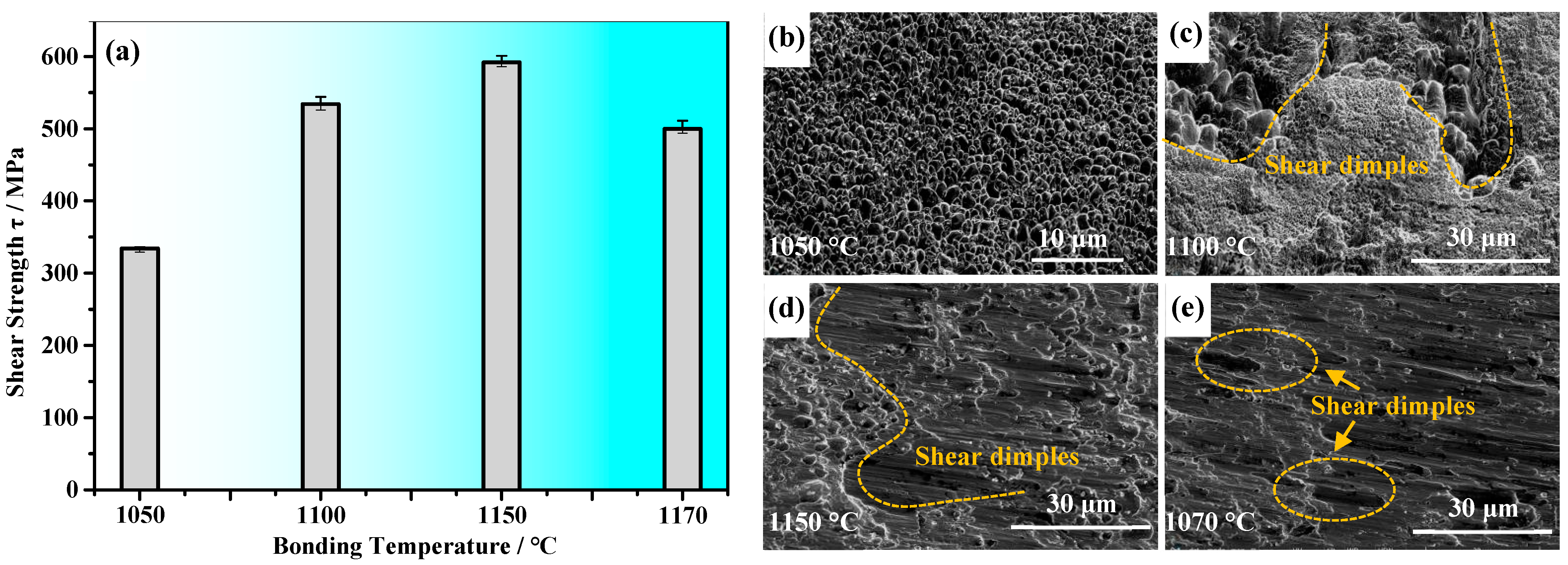
| Materials | Al | Co | Cr | Ti | Ta | Nb | Mo | W | Zr | B | C | Ni |
|---|---|---|---|---|---|---|---|---|---|---|---|---|
| FGH98 | 7.44 | 19.94 | 14.16 | 4.5 | 0.77 | 0.56 | 1.58 | 1.20 | 0.03 | 0.56 | 0.71 | 48.55 |
| MEA | 3.12 | 31.21 | 30.92 | 2.88 | 31.87 |
| Number | Welding Temperature T/°C | Welding: Pressure P/MPa | Welding Time t/h | Heat Treatment Temperature, T/°C | Heat Treatment Time, t/h |
|---|---|---|---|---|---|
| No.1 | 1050 | 5 | 1 | 850 | 3 |
| No.2 | 1100 | ||||
| No.3 | 1150 | ||||
| No.4 | 1170 |
| Point | Al | Ti | Ni | Cr | Co | Possible Phase |
|---|---|---|---|---|---|---|
| 1 | 8.8 | 10.9 | 70.0 | 2.6 | 7.6 | Ni3(Al, Ti) |
| 2 | 8.0 | 9.5 | 66.6 | 5.5 | 9.9 |
Publisher’s Note: MDPI stays neutral with regard to jurisdictional claims in published maps and institutional affiliations. |
© 2021 by the authors. Licensee MDPI, Basel, Switzerland. This article is an open access article distributed under the terms and conditions of the Creative Commons Attribution (CC BY) license (https://creativecommons.org/licenses/by/4.0/).
Share and Cite
Du, Y.; Li, Z.; Xiong, J.; Chen, Y.; Li, S.; Li, J.; Dong, J. Diffusion Bonding of FGH 98 and CoCrNi-Based Medium-Entropy Alloy: Microstructure Evolution and Mechanical Tests. Crystals 2021, 11, 1158. https://doi.org/10.3390/cryst11101158
Du Y, Li Z, Xiong J, Chen Y, Li S, Li J, Dong J. Diffusion Bonding of FGH 98 and CoCrNi-Based Medium-Entropy Alloy: Microstructure Evolution and Mechanical Tests. Crystals. 2021; 11(10):1158. https://doi.org/10.3390/cryst11101158
Chicago/Turabian StyleDu, Yajie, Zhaoxi Li, Jiangtao Xiong, Yipeng Chen, Shiwei Li, Jinglong Li, and Jihong Dong. 2021. "Diffusion Bonding of FGH 98 and CoCrNi-Based Medium-Entropy Alloy: Microstructure Evolution and Mechanical Tests" Crystals 11, no. 10: 1158. https://doi.org/10.3390/cryst11101158
APA StyleDu, Y., Li, Z., Xiong, J., Chen, Y., Li, S., Li, J., & Dong, J. (2021). Diffusion Bonding of FGH 98 and CoCrNi-Based Medium-Entropy Alloy: Microstructure Evolution and Mechanical Tests. Crystals, 11(10), 1158. https://doi.org/10.3390/cryst11101158







